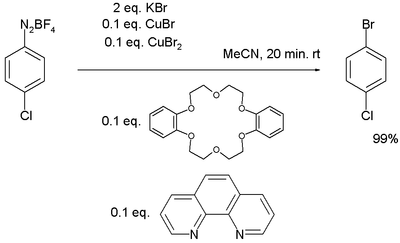Sandmeyer reaction
The Sandmeyer reaction is a chemical reaction used to synthesize aryl halides from aryl diazonium salts.[1][2][3] It is named after the Swiss chemist Traugott Sandmeyer. The reaction is a method for substitution of an aromatic amino group via preparation of its diazonium salt followed by its displacement with a nucleophile, often catalyzed by copper(I) salts. The nucleophile can include halide anions, cyanide, thiols, water, and others. The reaction does not proceed well with the fluoride anion, but fluorination can be carried out using the related Balz–Schiemann reaction.
Reaction mechanism
An aromatic (or heterocyclic) amine quickly reacts with a nitrite to form an aryl diazonium salt, which decomposes in the presence of copper(I) salts, such as copper(I) chloride, to form the desired aryl halide.[4][5] It is carried out at the temperature of 25-30 degrees Celsius. The reaction is a radical-nucleophilic aromatic substitution.
Several improvements have been made to the standard procedures.[6][7]
Variations
The majority of variations of the Sandmeyer reactions consist of using various copper salts.[8][9] For example, using cuprous cyanide produces benzonitriles.[10] Substituting thiols or water for the copper salts generates thioethers or phenols, respectively.
The Schiemann reaction uses tetrafluoroborate and delivers the halide-substituted product, fluorobenzene, which is not obtained by the use of copper fluorides.
Sandmeyer reactions with copper salts used in catalytic amounts are also known. One bromination protocol employs a 0.2 equivalent Cu(I)/Cu(II) mixture with additional amounts of the bidentate ligand phenanthroline and phase-transfer catalyst dibenzo-18-crown-6:[11]
Amyl nitrites are also useful as reagents in a modification of the Sandmeyer reaction. The reaction of the alkyl nitrite with an aromatic amine in a halogenated solvent produces a radical aromatic species, this then abstracts a halogen atom from the solvent. For the synthesis of aryl iodides diiodomethane is used,[12][13] whereas bromoform is the solvent of choice for the synthesis of aryl bromides.[14]
References
- ^ Traugott Sandmeyer (1884). "Ueber die Ersetzung der Amidgruppe durch Chlor in den aromatischen Substanzen". Berichte der deutschen chemischen Gesellschaft. 17 (3): 1633–1635. doi:10.1002/cber.18840170219.
- ^ Traugott Sandmeyer (1884). "Ueber die Ersetzung der Amid-gruppe durch Chlor, Brom und Cyan in den aromatischen Substanzen". Berichte der deutschen chemischen Gesellschaft. 17 (4): 2650–2653. doi:10.1002/cber.188401702202.
- ^ Ludwig Gattermann (1890). "Untersuchungen über Diazoverbindungen". Berichte der deutschen chemischen Gesellschaft. 23 (1): 1218–1228. doi:10.1002/cber.189002301199.
- ^ J. K. Kochi (1957). "The Mechanism of the Sandmeyer and Meerwein Reactions". J. Am. Chem. Soc. 79 (11): 2942–2948. doi:10.1021/ja01568a066.
- ^ H. H. Hodgson (1947). "The Sandmeyer Reaction". Chem. Rev. 40 (2): 251–277. doi:10.1021/cr60126a003.
- ^ M. P. Doyle, B. Siegfried and J. F. Dellaria (1977). "Alkyl nitrite-metal halide deamination reactions. 2. Substitutive deamination of arylamines by alkyl nitrites and copper(II) halides. A direct and remarkably efficient conversion of arylamines to aryl halides". J. Org. Chem. 42 (14): 2426–2431. doi:10.1021/jo00434a017.
- ^ Suzuki, N. et al. Perkins Trans. I 1987, 645.
- ^ Jonathan L. Hartwell (1955). "o-Chlorobromobenzene". Organic Syntheses; Collected Volumes, vol. 3, p. 185.
- ^ F. D. Gunstone and S. Horwood Tucker (1963). "1-Chloro-2,6-dinitrobenzene". Organic Syntheses; Collected Volumes, vol. 4, p. 160.
- ^ H. T. Clarke and R. R. Read (1941). "o-Tolunitrile and p-Tolunitrile". Organic Syntheses; Collected Volumes, vol. 1, p. 514.
- ^ P. Beletskaya, Alexander S. Sigeev, Alexander S. Peregudov, Pavel V. Petrovskii (2007). "Catalytic Sandmeyer Bromination". Synthesis. 2007 (16): 2534–2538. doi:10.1055/s-2007-983784.
{{cite journal}}: CS1 maint: multiple names: authors list (link) - ^ W. B. Smith; O. C. Ho (1990). "Application of the isoamyl nitrite-diiodomethane route to aryl iodides". J. Org. Chem. 55 (8): 2543–2545. doi:10.1021/jo00295a056.
- ^ V. Nair; S. G. Richardson (1982). Synthesis: 670–672.
{{cite journal}}: Missing or empty|title=(help) - ^ J. I. G. Cadogan; D. A. Roy; D. M. Smith (1966). "An alternative to the Sandmeyer reaction". J. Chem. Soc.: 1249–1250. doi:10.1039/J39660001249.


